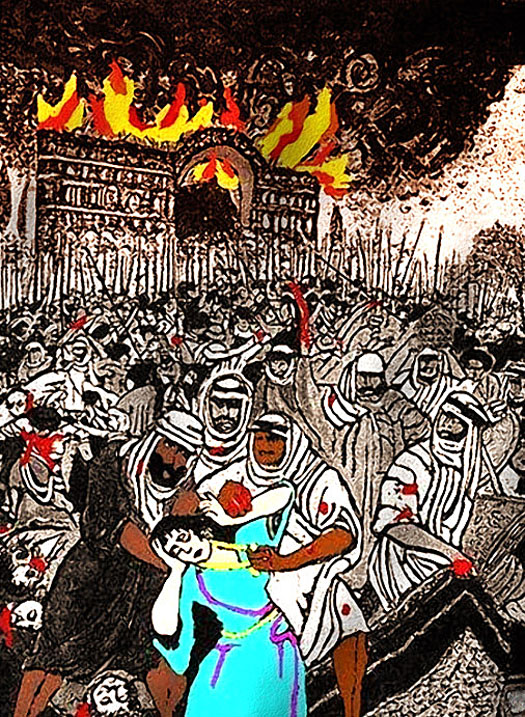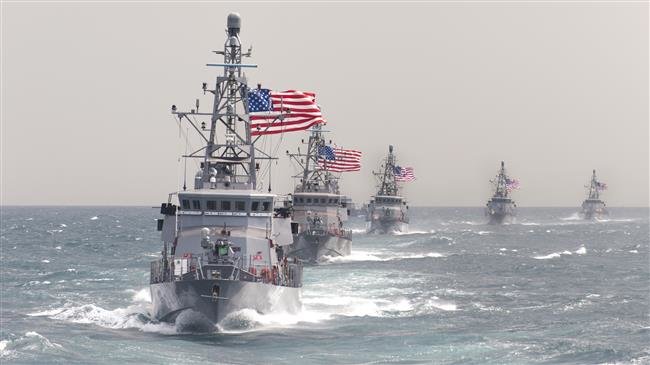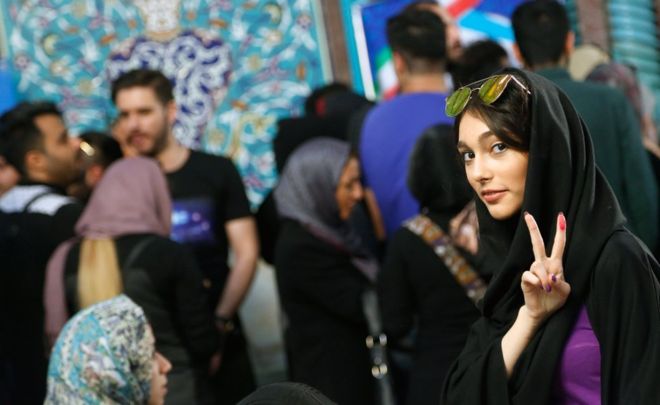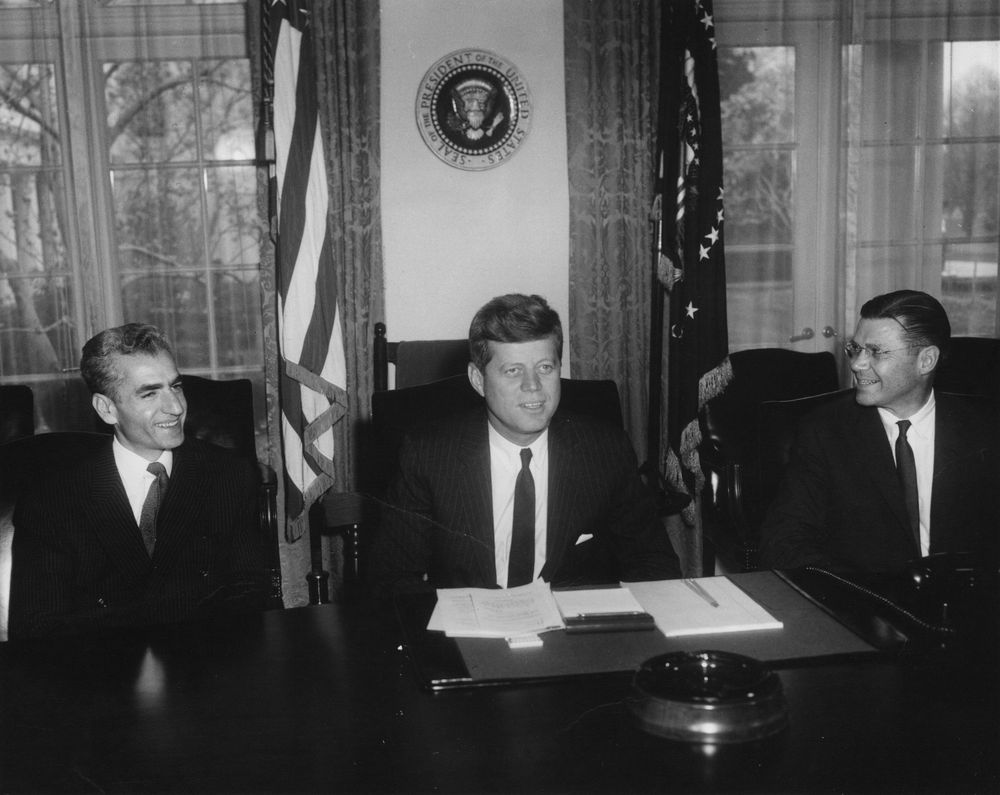To hear the likes of Rudi Giuliani, John Bolton or Mark Dubowitz of the Foundation for the Defense of Democracies, the sole problem between the U.S. and Iran is the latter’s radical regime. They argue that if only the regime were removed from power, the United States would enjoy strong ties with a “Free Iran” and all the outstanding issues over the past 40 years would just disappear. Israel’s Prime Minister, Binyamin Netanyahu, has also weighed in, addressing Iranians on social media and stating that, in a post-Islamic Republic future, Israel and Iran can be the best of friends.
Some Iranians and Israelis point to the ancient bond between Iran and the Jewish people, going back to the time of Cyrus the Great, the founder of the Achaemenid Persian empire, who liberated Judaean exiles from captivity in Babylonia and proclaimed the freedom of religion and equality of all races. His successors helped rebuild the Temple of Solomon, earning Persia a respect in Judaism shown to no other gentile nation. This is far from the stated goal of the current Islamist regime in Tehran which is to “wipe Israel off the map” and drive America out of the region. However, it could also be argued that, if Cyrus were still alive today, the magnanimous ruler might support Palestinian refugees and their descendants being allowed to return to their homes within Israel, an objective the ayatollahs repeatedly insist as just as important as the liberation of Islamic holy sites in Jerusalem.
Another more nuanced view, particularly in European circles, believes that the broken relationship between Iran and the West is a consequence of western imperalistic expansionism over the last 100 years at the expense of Iranian interests, as described by William Morgan Shuster in his excellent book published in 1912, “The Strangling of Persia”. With a more understanding approach that accommodates its legitimate concerns, Iran can eventually become an ally of the West and not a foe.
Iran has been in conflict with Western civilization throughout much of its 2500 year existence.
Unfortunately, both of these positions are largely based on historical revisionism rather than reality. As any serious scholar of the Near East knows, Iran has been in conflict with Western civilization throughout much of its 2500 year existence. Those who have read Herodotus, or at least seen the movie “300”, or its 1960s predecessor “The 300”, should know that the conflict began when Persia clashed with the Greek city states over control of western Anatolia. It led to King Xerxes invading Greece in 480 BC to end the menace they posed to his empire that encompassed much of the population and territory of the Near East (and beyond). Although the invasion ultimately failed, the Persians regained hegemony of the eastern Mediterranean region in the Peace of Antalcidas in 387 BC before their empire was later invaded and destroyed by Alexander 50 years later. Creating a land-route to the Mediterranean, as well as a naval base to project its reach, is something that Washington sees as unacceptable but which Tehran regards as a vital aspect of its regional strategy.
The Arsacid dynasty (often referred to as the Parthian empire), restored Persian control and drove the descendants of Alexander’s generals, the Seleucids, out of Iran and the region. The Roman conquest of Greece, however, extended its domain into the eastern Mediterranean. The subsequent wars between the Roman and the Arsacid, and later Sassanid, dynasties raged for nearly 700 years – arguably the longest period of conflict between any two states in world history. Ironically, Syria was the main battle ground between the two empires, with the Persians achieving a notable victory at Edessa in 260 CE resulting in the humiliating capture of the Roman emperor, Valerian. Later in 615 CE, the Persian king, Khosrow, took the city of Jerusalem from the Byzantines (Eastern Romans) which allowed him to invade and conquer Egypt. Jerusalem was always considered by the Persians to be of great strategic importance because it is situated at the nexus of Africa, Asia and Europe.
The Arab conquest of Iran in the mid 7th century, which led to the Islamicization of the country, for a long time ended Persia as an independent regional power although Persians occupied the highest positions in the administration of the Sunni Abbasid caliphate in Baghdad. Many pro-monarchist Iranians accuse Tehran of ignoring and betraying the glorious pre-Islamic past: Prince Reza Pahlavi has called the Iranian government “anti-Iranian” because it eliminated the centuries-old “Lion and Sun” emblem in the national flag (that is actually of Mesopotamian origin). But Islamic civilization itself evolved, in large part out, of the ruins of the Sassanid empire which is what Tehran, according to the British ruling class and Arab leaders, is accused of seeking to revive. The four crescents of the current emblem resemble the four points of the star image of the Sassanian “Derafsh Kaviani”.

During First AIOG (Arabo Islamic Invasion Occupation) 635 AD – 651 AD
Fall of Ctesiphon 638 AD
Although the crusades are not really seen as a clash between Iran and the West, the Turkic Seljuk empire that fought against the first one located their capital in the Iranian city of Esfahan, and their court was a quintessentially Persian one. The crusade, declared in 1095 by Pope Urban II, was ostensibly to liberate the holy city of Jerusalem from Seljuk rule and safeguard the passage of Christian pilgrims. It had a profound, lasting effect on how Muslims would come to view the West. Unlike in previous conflicts, where there was a secular reason for going to war – such as over borders or imperial prestige – the crusade took on a religious significance for both the aggressors and those defending the holy land from their depredations. Many Muslims identify the conflict as a Manichaean struggle between Daar-al-Harb (The House of War) versus Daar-al-Islam (The House of Islam/Peace), the latter being resolved to expel the former from its territory as a matter of jihad.
Defending the city of Jerusalem (Al-Qods) would become a sacred duty for Iranians and other Muslims. This is deeply embedded in the mindset of the Iranian ruling elite. It is strongly evident in Ayatollah Khomeini’s call for his soldiers to march on the “Road to Jerusalem” following the retreat of Saddam Hussein’s hordes in 1982 that had invaded Iran two years earlier. The Islamic Republic’s annual “Qods Day” march, staged throughout the world, reflects this rallying call. Recapturing Jerusalem from its “Zionist occupiers”, would serve to restore Persian dominance within the region.
Some might regard this as drawing facile parallels of little relevance to contemporary international relations. After all, England and France have a long history of warfare between them but are now the closest of allies. However, national memory is a very important part of Persian culture. Iranians commemorate the battle of Karbala in 680 CE, and the associated martyrdom of Imam Hussein, the second imam of the Shia, during the ceremony of Ashura as if the bloody event happened yesterday.
Few, however, can deny the political relevance of the last 400 years of Iran’s interactions with European states of the post-Renaissance period. This began with the expansion of the Portuguese empire, a global superpower of the 16th century, into the Persian Gulf, which Iran has long considered to be its own backyard. Like the U.S fifth fleet, the Portuguese navy set up base on the island of Bahrain in 1521 and at other areas on the shoreline of the Gulf. And as Tehran does today with the American armada patrolling off its coast, the Iranian rulers of the Safavid dynasty considered this a threat to their security and insult to national pride. They fought back and drove the Portuguese out of the region a century later, resuming their traditional role as guardians of the Gulf.

Although the English had long cultivated a good relationship with Iran during the Safavid dynasty, and even helped in expelling the Portuguese, relations turned sour as the British took more interest in protecting their presence in India. This meant that Persia was not allowed to have any influence in the Persian-speaking areas of Afghanistan which Great Britain wanted to remain a buffer state free from Russian ingression. When the Persians seized Herat in 1856, the British responded by invading the Iranian hinterland and defeating the Persians at Kushab, forcing them into a humiliating retreat from Herat, something that is still bitterly resented. Countering Iranian influence in Afghanistan remains an important objective of the United States and NATO who don’t want the country falling either to the Taliban or to Tehran following an eventual withdrawal from the country.
Iran unlike adversaries/rivals of the United States, like Russia and China, thus, has a long history of conflict and rivalry with western states for control of the Near East. The Russians, after all, were allies of the Allied powers of Europe against Napoleon and Hitler – for which Putin is always at pains to point out. China may have bitter experiences of humiliation under the British with the Opium wars, but there is no history of conflict with the West extending back through the centuries.
In his list of twelve demands that Iran must accede to, that was likely drafted by national security advisor John Bolton, Secretary Pompeo effectively called for Iran’s unconditional surrender that would mean the country becoming little more than a vassal state of the United States and forgo any aspirations to regional hegemony as it has done for the past 2500 years. Although some of the demands seem reasonable, and Tehran could well acquiesce to them as part of a grand bargain, the insistence that Iran be deprived of ballistic missiles and that it permanently cease uranium enrichment is simply impossible as far as Iranian national security and sovereignty are concerned.
Any Iranian government representative of the will of its people would find the terms unacceptable, and beneath the dignity of the nation.
Any Iranian government representative of the will of its people would find the terms unacceptable, and beneath the dignity of the nation. Only a regime that prevents the popular will being expressed, such as that which existed before 1979, notoriously conceding immunity for American personnel in Iran from prosecution, would ever consent. The United States and Britain may have succeeded in overthrowing the popular Mossadegh government in 1953, but the Iranian people reasserted their country’s sovereignty 25 years later, and are unlikely to forswear their cherished national rights.
Recent protests in Iran, reflecting unprecedented levels of discontent and anger at state corruption and the incompetence of the Rouhani administration, have led some to thinking that the Iranian regime is about to collapse. Reuel Marc Gerecht and Michael Ledeen have written article after article for the better part of a decade claiming that the Islamic Republic is where the Soviet Union was just before its demise in 1991. This comparison is completely flawed, of course. Iran is not a multinational empire with independence movements threatening its existence, as was the case with the USSR in its final few years, nor is its political or economic system in dire need of rehabilitation.

The Islamic Republic still enjoys the support of the religious masses, and manages to attract large participation in its elections and public rallies. Its economy, although plagued by mismanagement and corruption, has no trouble in providing basic goods that people depend on, in contrast to the long queues for milk and bread of the late USSR. The ruling establishment of clerics and Revolutionary Guards has no intention of meekly folding like the Shah’s regime did in 1978/9 when it failed to deal with the protest movement led by by a charismatic leader who had the support of the people. Moreover, making comparisons with the Soviet Union seem futile considering that the Kremlin elite, after the USSR’s collapse in 1991, reinvented themselves as nationalists and the West has an even more difficult relationship with Russia led by former KGB officials like Vladimir Putin.
Another aspect of the protests are the slogans for Iran to extricate itself from regional conflicts and focus solely on the needs of the Iranian people: “No to Gaza, Palestine and Syria, I sacrifice myself only for Iran!” and even “Down with Palestine!” The influence of foreign Persian-language media, telling Iranians that all of their money is being wasted on “foreign adventures”, can no doubt be seen in this. However, for the ruling elite, Lebanon, Palestine and Syria are frontiers and border posts of Iran’s historical domain and sphere of influence. Retreating from them is just not an option for Iranian security and would only embolden Iran’s regional rival, Saudi Arabia. Michael Rubin of the American Enterprise Institute is thus quite wrong when he states Iran has “no natural interest” in what happens to Syria and Iraq. Both nations are at the very heart of the region that Iran belongs to.
Even if the current entrenched regime were extirpated, peacefully or violently, it is not clear that a new regime would change much of the country’s foreign policy. A secular nationalist government in Tehran might be less willing to make alliances with the likes of Hezbollah and Hamas. But it would be wary of cutting off ties with both. If Iran is to maintain any regional clout, it needs to focus on solidarity with Shias with whom it has a natural influence over. Iran may have ethnic and cultural ties to the Kurds, but it has little in common with its Arab neighbors other than religion. Moreover, fostering ties with the Sunni Palestinians is essential for the sake of realpolitik rather than ideology. As long as Iran continues to champion the Palestinian cause, it cannot be so easily made out by the Saudis and others as the principal enemy of the Arab World which it would certainly be otherwise.
The last Shah of Iran, Mohammad Reza Pahlavi, was 100% a client of Washington and instrument of American power in the region. But his desire to make Iran the “fifth superpower” rankled many in the Carter administration and in Congress. They suspected that the vast quantities of advanced weaponry that they were selling him might be used by the Shah to rebuild the Persian empire of old which he constantly referred to and believed he was the successor to. One can only speculate, but it is quite possible that, had the 1979 revolution not happened, relations between Iran and the United States would have become strained as Tehran increasingly asserted itself as the regional gendarme.

President Trump has adopted and extremely tough stance against Iran as part of an effort to push back on its “regional aggression”. Many analysts thought that the resolution of the nuclear issue meant that Iran was home and dry to not only rebuild its economy and conventional military, but also to pursue more forcefully its regional ambitions. Three years after the JCPOA was agreed, Tehran has succeeded in defeating ISIS and protecting the governments in Damascus and Baghdad along with its influence over them. That can be considered a major accomplishment. But with the restoration of “crippling sanctions”, Tehran finds itself on the back foot again. Hardliners in the Iranian regime may feel vindicated by America’s abrogation of the nuclear deal, and that Rouhani was naïve to trust the West, but sanctions will limit Iran’s ability to fund its national security agenda and also to keep its core base happy with welfare and public services. Rouhani’s main conservative challenger in the 2017 presidential election, Ebrahim Raisi, promised to increase subsidy pay-outs to the poor. If sanctions limit Iranian oil exports much, this potential vote-winner cannot be realised.
Trump may actually be pushing the two countries towards a rapprochement after he likely loses the White House in 2020.
Trump may actually be pushing the two countries towards a rapprochement after he likely loses the White House in 2020. The leadership in Tehran must surely realize that only by re-establishing diplomatic ties and resolving all of the outstanding disputes between Iran and the United States can they benefit from sanctions relief in the long-term. The hawkish senator, Tom Cotton of Alabama, was entirely correct when he co-authored an open letter addressed to the Iranian leadership that congressional approval was necessary for the lifting of sanctions agreed in the JCPOA to continue after Obama left. The Iranian economy may survive by adapting to U.S secondary sanctions, but it cannot thrive as it needs to if Iran is to provide employment opportunities to its restive youth. Indeed, despite their intense rivalry over the centuries, and open hostility, Iran and the West have always traded with each and not waged economic warfare. The clerical-led boycott in response to the 1890 tobacco concession to the British is a rare exception. U.S sanctions also don’t come cost free as some think – they annoy U.S allies and upset the oil market, increasing prices at the pump.
The Roman and Persian empires, moreover, weakened each other rather than dealing with the threat from common enemies such as the Huns, Turks and Arabs who would eventually overwhelm them. The United States, as the “New Rome”, and Iran have been undermining each other for the last four decades and have failed to accommodate each other except on specific occasions of limited duration. They have entrenched themselves into believing the other side will eventually give up as part of a Reaganesque zero-sum “we win, they lose” strategy. But this is only a recipe for instability.
Iran’s quest for regional supremacy did not begin in 1979 with the Islamic revolution or in earnest in 2003 following the Iraq war: It began when with the founding of the ancient nation by Cyrus the Great. American foreign policy makers need to recognize this, and not pin themselves to any false hope that regime capitulation or collapse will somehow make good of all America’s mainly self-inflicted problems in the Middle East. Iran and the West will always be rivals, but they can also reach a modus vivendi that allows them to manage their competition for influence without ruining the region they want to control. Anti-American ayatollahs and Iran hawks in Congress should pay heed to the words of Friedrich Nietzsche, “Be careful who you choose as your enemy because that’s who you become most like.” Indeed, Tehran and Washington have more in common than they admit.






